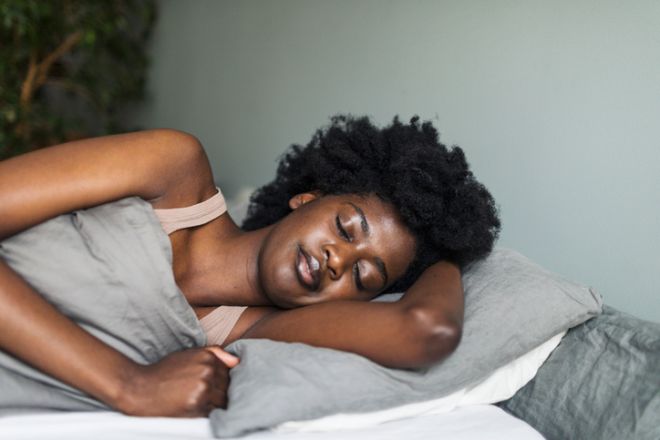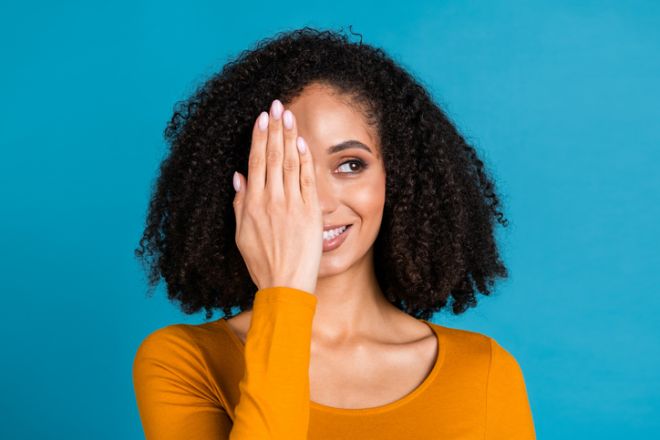Can Side-Sleeping Cause Facial Asymmetry?
Could Sleeping On Your Side Cause Facial Asymmetry? Here’s What You Need To Know
Share the post
Share this link via
Or copy link

Facial asymmetry can make people fixate on their appearance, especially if they’re concerned about a cheek or jawline appearing lopsided or uneven. Many TikTok users have been discussing this issue recently, with some suggesting that frequently sleeping on one side could be the cause of the misalignment. In response, several users have been trying to sleep on their backs, hoping to correct the issue.
More research is needed.
While this method sounds reasonable in theory, Dr. Prem Tripathi, a board-certified facial plastic surgeon at Bay Hills Plastic Surgery in Alamo, California, points out that more research is needed to determine if side-sleeping actually causes facial asymmetry. As of now, there are no studies to support the idea that prolonged pressure from sleeping on one side of the face can lead to structural changes in the bones of the cheek and jaw, Dr. Tripathi explained in an interview with Self published on March 28.
“If you were on one side eight hours a night, for years and years and years, you could maybe develop some asymmetry,” Dr. Tripathi explained, but you would have to be lying down perfectly still for decades, and never tossing or turning. Even then, the changes to your face would be subtle.
Dr. Tripathi believes that the growing obsession with facial asymmetry may stem from a 2016 study published in the Aesthetic Surgery Journal, which proposed that side sleeping could lead to wrinkles and “skin distortion” on the side of the face that bears the most pressure.
“Compression, shear, and stress forces act on the face in lateral or prone sleep positional,” the study notes.
RELATED CONTENT: What A Pretty Kitty — Labia Puffing Is The New NSFW Cosmetic Trend On The Rise
While this could potentially make your face appear uneven, Dr. Tripathi shared a few key points. First, the study has limitations, including a narrow literature review, meaning it doesn’t definitively prove that sleeping on one side is responsible for any facial lopsidedness. Moreover, the research didn’t isolate sleep position as the sole cause of fine lines—other factors, such as uneven sun exposure, can also cause one side of the face to age more quickly, resulting in a “saggier,” “looser,” or more “wrinkled” appearance.
- ‘The Street I Grew Up On Is Now Named After Me’ — Trailblazer Dominique Morgan On Pride, Power And Blackness
- Gym Etiquette 101: 10 Rules Every Respectful Member Should Follow
- Xscape Talks Platinum Single, Balancing Motherhood, And Kicking Off Their Summer Tour Without Exiled Group Member LaTocha Scott [Exclusive]
Uneven chewing, genetics, and smoking can cause facial asymmetry.

Dr. Melanie Palm adds that several other factors contribute to facial asymmetry, with genetics playing a significant role. Studies, such as a 2018 one involving nearly 200 volunteers, have also shown a link between aging and increased facial asymmetry. As people age, although bones stop growing after puberty, cartilage continues to develop. This leads to changes in facial features, particularly the ears and nose, which continue to grow. Additionally, soft tissues in the face begin to relax and sag over time.
Lifestyle choices can also contribute to asymmetry. For example, Medical News Today noted that smoking exposes the face to harmful toxins and can cause vascular problems, while uneven chewing habits have been shown to affect craniofacial growth, further contributing to facial asymmetry.
“All of us are a little asymmetric,” Dr. Palm told Self flat out.
If you’re planning to sleep on your back tonight in hopes of fixing facial asymmetry, it’s unlikely to be the most effective solution. To truly address the issue, you may need surgical options like a facelift or blepharoplasty (eyelid surgery), but it’s important to consult with your medical provider. Alternatively, non-surgical treatments such as dermal fillers or Botox can also help improve symmetry.
RELATED CONTENT: The Great Implant Exodus: 5 Celebrities Who Are Done With Cosmetic Surgery
- ‘The Street I Grew Up On Is Now Named After Me’ — Trailblazer Dominique Morgan On Pride, Power And Blackness
- Gym Etiquette 101: 10 Rules Every Respectful Member Should Follow
- Xscape Talks Platinum Single, Balancing Motherhood, And Kicking Off Their Summer Tour Without Exiled Group Member LaTocha Scott [Exclusive]









